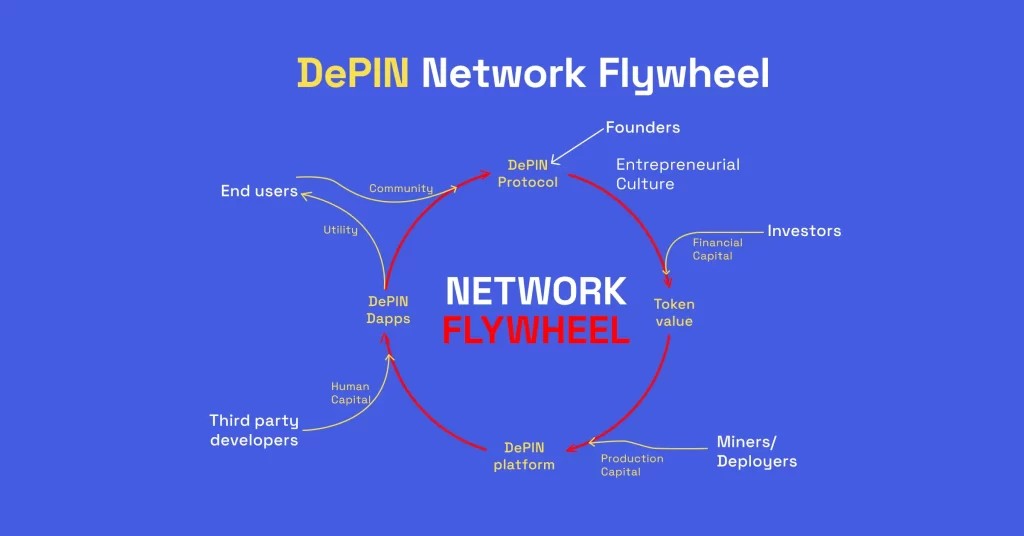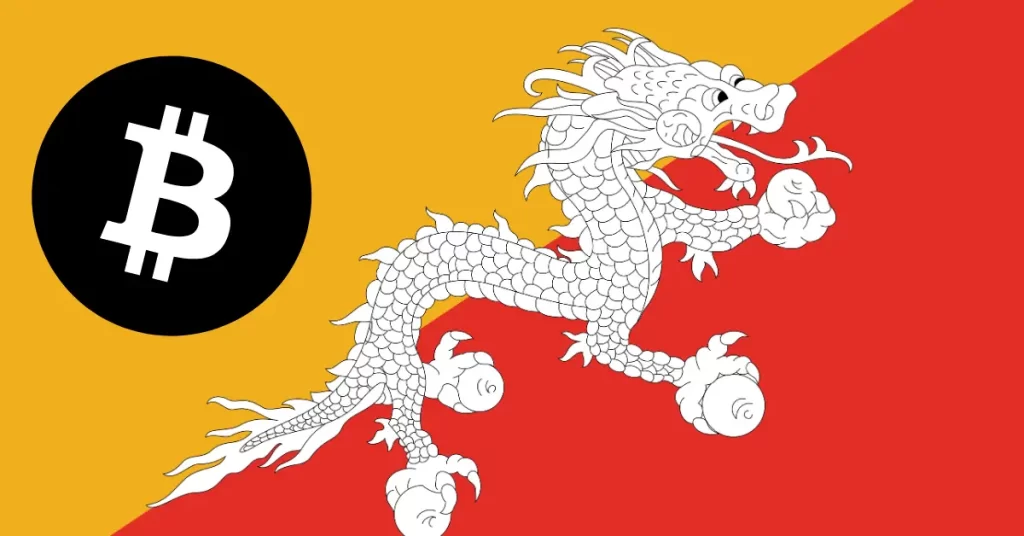
The post What is DePIN? A Beginner’s Guide to Decentralized Physical Networks appeared first on Coinpedia Fintech News
DePin, short for Decentralized Physical Infrastructure Network, represents the natural evolution of blockchain technology beyond Web3 and into the physical world.
As blockchain and decentralized solutions gain traction, DePin has emerged as a topic of growing interest. While still in its early stages, this innovative concept has the potential to disrupt existing technologies and create more efficient solutions across various sectors.
But, what exactly is DePin? How does it work? And why is everyone suddenly talking about it?
What is DePin?
DePin is just an umbrella term for all networks that use blockchain to decentralize control or ownership over physical infrastructure. So, DePin includes a network of crowd-sourced providers.
Here, these providers offer real-world services to users and use blockchain to keep a record of these services. In turn, they receive rewards (for the services) via cryptocurrency that might run on the same or a completely different blockchain network.
Imagine a world where, instead of relying on large corporations, we depend on OURSELVES to run systems. By sharing resources like computers, internet access, or even solar panels, we collectively build and sustain infrastructure.
Let’s simplify it further.
Say you and your friends need a wifi network. However, instead of relying on one big company to provide it, you all chip in by setting up your own small Wi-Fi devices. These devices can now create a big network together and everyone has access.
What’s cool is that no single person owns the network. It’s run by everyone who contributes to it.
In addition, say, when you build or maintain the network by setting up the device, you can earn rewards too. This is an idea of sharing both responsibilities and rewards. Right?
DePin is based on this idea. Think of teamwork but on a broader, more global scale.
DePin leverages blockchain and token-based rewards to decentralize infrastructure, reducing reliance on large corporations and breaking their monopolies. It’s a concept applicable across diverse sectors, from transportation and energy to wireless connectivity.
Now that we’ve covered the basics, let’s explore the different categories of DePin.
Categories of DePin.
DePin networks can be broadly classified into two categories:
- Physical Resource Networks (PRNs): These focus on tangible, physical resources such as raw materials, transportation, or facilities.
- Digital Resource Networks (DRNs): These manage intangible, digital resources like data, software, or information.
While both aim to optimize resources, their domains of operation—physical versus digital—set them apart.
How Does DePin Work?
DePin combines blockchain technology with real-world physical infrastructure to create shared, decentralized networks. Here’s how it works:
- Start with a Physical Resource
Examples include a wireless hotspot, an electric vehicle charger, or a data storage device. These assets aren’t controlled by a single company but are instead distributed among individuals contributing to the network. Think back to the Wi-Fi example we discussed earlier.
- Blockchain for Coordination
A blockchain network manages and coordinates these distributed resources, ensuring transparency, security, and decentralization.
- Rewards for Contributors
Contributors earn tokens for sharing their resources. This incentive model encourages broader participation.
- End-Users Pay for Services
Users accessing these services can pay using tokens or, in some cases, traditional payment methods, depending on the network’s setup.
- Smart Contracts at Work
Smart contracts automate transactions, rewards, and agreements, eliminating the need for central authorities. They execute predefined actions seamlessly and securely.
For example, let’s consider the Helium Network project. It is a DePin project where individuals deploy wireless hotspots for IoT devices and earn HNT (cryptocurrency) to share network coverage. Then people can connect their devices to hotspots and pay in tokens for the data they use.
Interesting, right?
Technology Used in DePin
DePin is like a smart system where people share physical resources—Wi-Fi, storage, energy—and get rewarded for their contributions. Here’s a breakdown of the core technologies that power DePin:
- Blockchain:
Say you find a giant, super-secure notebook where every action is written down and can’t be erased. That is blockchain! It keeps track of who’s sharing what and makes sure everyone gets rewarded fairly. And there’s no way for unfair practices.
- Tokens:
When you help out by sharing something, you can earn in tokens. These are like digital reward points and you can use them to buy something cool or even trade for real money. It’s how DePIN says, “Thanks for helping!”
- IoT Devices:
If you’ve seen gadgets like sensors, cameras, or Wi-Fi hotspots, they are the little helpers in DePIN. They collect data or provide services and return that information to the network. You can say they are the worker bees of the system.
- Smart Contracts:
Smart contracts are automated agreements that execute actions based on predefined conditions. For example, if someone shares a Wi-Fi hotspot, a smart contract can instantly reward them with tokens without needing any middleman.
- P2P Networks:
Instead of going through a big company’s server, people in DePIN talk directly to each other. It’s like sharing files or streaming a movie directly from a friend’s computer. It’s of course faster and cheaper, with no bossy middlemen.
- Storage and Compute:
You also have a giant shared garage where everyone offers some of their unused space or computer power. Did you say you need a place to store your files or run some heavy tasks? DePIN’s got your back through this shared system.
- AI and Data:
What happens to all the data from devices and users? AI can make sense of it—like figuring out where a Wi-Fi hotspot is most needed or how to use certain resources more efficiently. It’s the brain behind the scenes.
- Governance:
Since there’s no almighty leader in DePIN, everyone who owns tokens can vote on important stuff. We can decide about making upgrades or changing how rewards work. It’s teamwork at its best!
So, in short, DePIN uses cutting-edge tech like blockchain, tokens, and smart gadgets to let people share resources directly, get rewarded, and make decisions together.

Core Principles of DePin
DePin is guided by key principles that set it apart from traditional systems. Think of them as the “rules of the game” that ensure fairness, inclusivity, and growth.
- We go back to decentralization.
As we already know, here, power is in the hands of people. There’s no one individual controlling everything. Power is spread out among people who participate in the game. Everyone has a role and no matter what they are sharing or using, they benefit from it.
- Incentives are driving participation
DePin supports a give-and-get model. You share something that adds value and get rewarded for it. The reward is tokens that have real value. They keep the motivation on. The more you contribute, the more you earn.
- Digital weds physical
DePin doesn’t just work on the internet, it connects the real world with the virtual one. Say:
- Wifi hotspot provides internet
- Sensors collecting weather data
- Storage devices hosting files
You use tech to solve problems in the real world in an efficient and helpful way.
- Everyone has open access:
DePin is an inclusive system. You don’t need technical expertise to participate. If you have a resource to share, you can join—no special qualifications required.
- Transparency for Trust
Blockchain technology ensures that all transactions and changes are visible to everyone. Whether it’s a token reward or a network upgrade, everything is transparent. No hidden deals, no sneaky edits—just open and fair processes.
- Decisions have to be community-driven
If you participate in the network, you can have a say in how it runs. You can vote and hold important decisions on upgrades and changes in rewards too. In this game, every member decides what happens next.
- Scalability drives growth
DePin is designed to grow. As more participants join and share resources, the network becomes stronger, faster, and more useful. This scalability benefits everyone involved, creating a win-win ecosystem.
Use Cases of DePin Across Industries
We already know DePIN (Decentralized Physical Infrastructure Networks) can really shake up a lot of sectors. While the idea seems simple, it can transform industries in amazing ways. We can go sector by sector and find out how:
Telecommunications
Say instead of big telecom companies owning all the towers and hotspots, people like you and me set up small devices and get paid for providing internet in our neighborhoods. Hold on to the thought for once. That’s the future!
- Use Case: The Helium Network is already doing this. Individuals set up IoT hotspots and provide wireless coverage for things like smart sensors. Don’t forget that they earn tokens as a reward.
- Why It’s Cool:
- It expands coverage to areas traditional telecoms overlook.
- It is cheaper for users too because it does not depend on the big middleman companies.
Energy and Utilities
What if your rooftop solar panels or home battery could contribute to a decentralized energy grid? You could sell your extra energy to neighbours and get paid directly.
- Use Case: Networks like Voltus help people contribute energy savings to grids and in turn earn rewards.
- Why It’s Cool:
- Firstly, it encourages renewable energy sharing.
- Next, it makes energy cheaper and more reliable, especially if you consider the remote areas.
Transportation and Mobility
Say there is a city where you share resources like electric vehicle (EV) charging stations or even parking spaces, and the system rewards you for participating.
- Use Case:
- Decentralized networks for EV charging can let us individuals host charging points at home or businesses. We can then earn tokens from drivers who use them.
- When someone has a shared bike or scooter program, they can use DePIN to ensure fair distribution and rewards.
- Why It’s Cool:
- It makes transportation more accessible and sustainable.
- DePin reduces reliance on big companies to build infrastructure.
Cloud Storage and Computing
Instead of paying big companies like Google or Amazon for cloud storage, you could store your files on a decentralized network where regular people like us can provide the space.
- Use Case: Filecoin and Storj let users rent out unused hard drive space to others.
- Why It’s Cool:
- We don’t have to worry about the security of files because they’re split into pieces and stored across multiple locations.
- It’s cheaper too because it uses people’s spare storage instead of giant data centers.
Healthcare and Life Sciences
Consider a world where your wearable fitness tracker (like a smartwatch) contributes health data to a decentralized network for medical research. And again, you get rewarded for it.
- Use Case: Decentralized networks can gather data for research on diseases like diabetes or Alzheimer’s but still keep your data private.
- Why It’s Cool:
- Patients can stay in control of their data.
- It helps researchers access more diverse and accurate information.
Smart Cities and IoT
Cities need lots of data to run efficiently. You need to have a check on traffic patterns, air quality, temperature, etc. Instead of governments installing expensive sensors everywhere, we can just deploy devices as we want and earn tokens to provide the data that they need.
- Use Case: Helium or similar networks can easily power smart city applications like air quality monitoring or traffic management.
- Why It’s Cool:
- It saves cities money while involving the community.
- The system makes smart city technology more accessible for smaller towns.
Supply Chain and Logistics
You know how tricky it can be to track goods as they move from factories to stores. DePIN can use sensors to monitor conditions like temperature and location in real-time and reward people who provide the infrastructure.
- Use Case: A decentralized network of GPS trackers and IoT devices keeps tabs on goods in transit.
- Why It’s Cool:
- You know the value of transparency, and you know exactly where your stuff is.
- It reduces costs by removing middlemen.
Media and Entertainment
Say you could share your unused bandwidth to help others stream videos or play games and earn rewards for it, would you skip it?
- Use Case:
- Decentralized video streaming platforms could use shared resources to host videos.
- Gamers could share unused computing power for rendering graphics or even hosting servers.
- Why It’s Cool:
- DePin makes streaming and gaming cheaper and faster.
- We can have our power back to users and leave out the giant platforms.
Finance and Insurance
You create micro-networks for peer-to-peer lending or decentralized insurance pools using DePin. Here people contribute funds to a shared pool and earn returns.
- Use Case: Farmers in rural areas could form insurance networks to protect against crop failures.
- Why It’s Cool:
- We can now make financial services accessible to underserved areas.
- DePin reduces reliance on big banks or insurers.
The Big Picture
DePIN stands out with its flexibility. It’s like the ultimate sharing economy—but actually powered by blockchain and real-world resources.
Benefits of DePin
DePIN is a cool concept but it’s more than that. It’s because it solves real-world problems while making systems fairer, more accessible, and more efficient. Perfect, right? But, what’s in it for us?
For Individuals: Earn and Participate
- Earn Rewards: If you have something to share, you can earn tokens. These tokens often have real-world value.
- Example: Running a Helium hotspot to provide Wi-Fi earns you tokens.
- Low Barriers to Entry: The best thing is the fact that anyone can participate. You do not need to be a tech wizard or have a big company backing you. You just need a resource to share!
It’s like getting paid for letting others borrow your extra stuff. How cool is that?
For Businesses: Efficiency and Cost Savings
- Lower Costs: Businesses don’t have to build massive infrastructure themselves anymore. They can just use DePIN networks to access storage, bandwidth, or data from people already providing them.
- Example: A startup can use Filecoin for cheap, decentralized file storage instead of paying for expensive centralized services.
- Scalability on Demand: DePIN can grow with demand. As more participants join, businesses can tap into more resources when they need them. And you do not need heavy upfront investments.
It’s like renting instead of owning—use what you need when you need it, and save money.
For Communities: Fair and Open Systems
- Local Benefits: People in communities can now set up and maintain infrastructure (like Wi-Fi hotspots or energy-sharing systems) to earn tokens. It keeps the benefits local instead of sending our profits to big corporations.
- Example: A rural area can set up a DePIN network to provide internet where big companies won’t invest.
- Democratic Governance: Decisions about the network—like how rewards are distributed—are often made by community voting.
It’s like having a neighborhood project where everyone contributes and shares the rewards.
For Technology and Innovation: Cutting-Edge Solutions
- Better Use of Resources: DePIN taps into unused resources like idle computers, extra internet bandwidth, or renewable energy. Instead of wasting these, they’re put to good use.
- Example: Unused storage on your computer becomes part of a global decentralized storage network.
- Innovation Without Monopolies: Since DePIN is decentralized, no single company can monopolize it. This encourages innovation and competition, making the system better for everyone.
It’s like turning leftovers into a gourmet meal—making the most of what’s already there.
For the Environment: Greener Solutions
- Energy Efficiency: DePIN often uses distributed networks, which can be more energy-efficient than centralized systems that rely on massive data centers or infrastructure.
- Example: A solar-powered device contributing to a network while earning tokens.
- Promotes Renewables: Networks can be built using clean energy sources shared by participants, reducing the reliance on fossil fuels.
It’s like sharing a carpool to save gas—efficient and eco-friendly.
For Users: Better Services and Lower Costs
- Improved Access: Services like internet, file storage, or computing become cheaper and more widely available because no middleman is hiking up prices.
- Example: A DePIN storage network can be more affordable and reliable than a big tech company’s service.
- More Choices: You get more choices because DePIN systems are decentralized, users can choose between multiple providers rather than being stuck with one big company.
It’s like shopping at a farmer’s market instead of a giant supermarket—you get more variety and better deals.
For the World: A Resilient Future
- No Single Point of Failure: As DePIN is decentralized, it might be harder for the network to go down. Even if one part fails, others keep working.
- Example: If one storage node goes offline, your data is safe on other nodes.
- Global Collaboration: DePIN connects people worldwide, creating a global network of contributors and users.
It’s like having a backup for your backup—always on and reliable.
Challenges of DePIN
Now that we all agree that DePIN is an amazing idea, it’s not easy. Like any big change, there are some tough corners we need to glide through.
Scaling Participation
- The Challenge: DePIN thrives on user participation, but onboarding individuals can be slow. Many are unfamiliar with blockchain or hesitant to contribute their resources.
- Why It Matters: The network’s effectiveness depends on widespread adoption. Without enough contributors, the system’s value diminishes.
- The Fix: Simplify onboarding with user-friendly interfaces and education campaigns that demystify blockchain and DePIN processes.
Handling Growth
- The Challenge: Small networks are manageable, but scaling up introduces technical bottlenecks. A sudden influx of users can lead to slower performance or even network failures.
- Why It Matters: A poor user experience during growth can drive participants away and damage trust in the network.
- The Fix: Develop scalable infrastructure and stress-test systems to ensure they can handle surges in demand without disruptions.
Regulation and Trust Issues
- The Challenge: Operating in the blockchain space often places DePIN networks in a regulatory grey zone. Users may also hesitate to trust a system that feels unfamiliar or lacks guarantees.
- Why It Matters: Without legal clarity and user trust, adoption becomes an uphill battle.
- The Fix: Work proactively with regulators to establish compliance and transparency. Build trust through open governance and robust security measures.
Balancing Rewards
- The Challenge: Designing fair incentives is tricky. Rewards that are too low fail to attract participants, while overly generous rewards can invite exploitation and unsustainable practices.
- Why It Matters: A poorly balanced reward system undermines network sustainability and participant satisfaction.
- The Fix: Use dynamic reward models that adjust based on contributions and market conditions to ensure fairness and sustainability.
Bridging the Tech Divide
- The Challenge: Rural or underserved areas, where DePIN could make the biggest difference, often lack the resources or knowledge to participate.
- Why It Matters: These gaps prevent DePIN from realizing its full potential as a tool for global equity.
- The Fix: Provide affordable starter kits, community-driven support, and partnerships to bridge the digital divide.
Competing with Centralized Giants
- The Challenge: Established companies like internet providers or cloud storage giants already dominate the space, with trust, money, and infrastructure on their side.
- Why It Matters: Competing against these giants can slow DePIN’s growth and adoption.
- The Fix: Highlight DePIN’s unique advantages like fairness, affordability, and community-driven governance to carve out a niche.
Managing Technical Complexity
- The Challenge: Blockchain and decentralized networks can be intimidating for newcomers, creating a barrier to entry.
- Why It Matters: High technical complexity limits participation to a small tech-savvy group, reducing inclusivity.
- The Fix: Develop intuitive interfaces and abstract the technical complexities to make participation accessible to all.
So, while DePIN has incredible potential to change how we share and use resources, it’s not without its growing pains. Want to hear the good news? These are challenges worth solving, and every step forward makes the system better for everyone.
The Future of Decentralized Physical Networks
When we try to imagine the future of Decentralized Physical Networks (DePIN), it’s exciting because it’s not just about technology. It’s also about changing the way we work, share, and live.
If we think about how the internet made the world smaller and connected us all, DePIN is like the next step. Now rather than just sharing information, we’re sharing real things: Wi-Fi, energy, storage, sensors, and more.
In the future, DePIN could make our lives much easier and more fair.
Just consider living in a place where everyone contributes to building local networks for the internet or energy. You do not have to wait for giant companies to show up, communities can create their own systems and keep the rewards.
Rural areas could finally have reliable internet. Cities could use smart sensors to manage traffic and pollution, all owned and run by the people who live there. We would finally be part of the process.
For businesses, this means a low barrier to entry. A small startup could access global resources and they don’t have to build massive infrastructure. This opens the door to new innovations and ideas because the tools are affordable and available to all of us.
It’s also super eco-friendly too. In the future, we could even see solar-powered DePIN nodes everywhere, turning clean energy into something valuable for everyone.
And let’s not forget how secure and resilient it will actually be. There would be no central point of failure. So, DePIN networks are much harder to shut down or control. Your data and services will always be accessible, no matter what happens in one part of the network.
Ultimately, the future of DePIN is all about empowerment. It puts control back in the hands of people, creating systems that are fair, inclusive, and long-lasting. It’s like creating a world where collaboration drives progress. That’s a future we’d all want to be a part of—no?

 1 month ago
25
1 month ago
25









 English (US) ·
English (US) ·